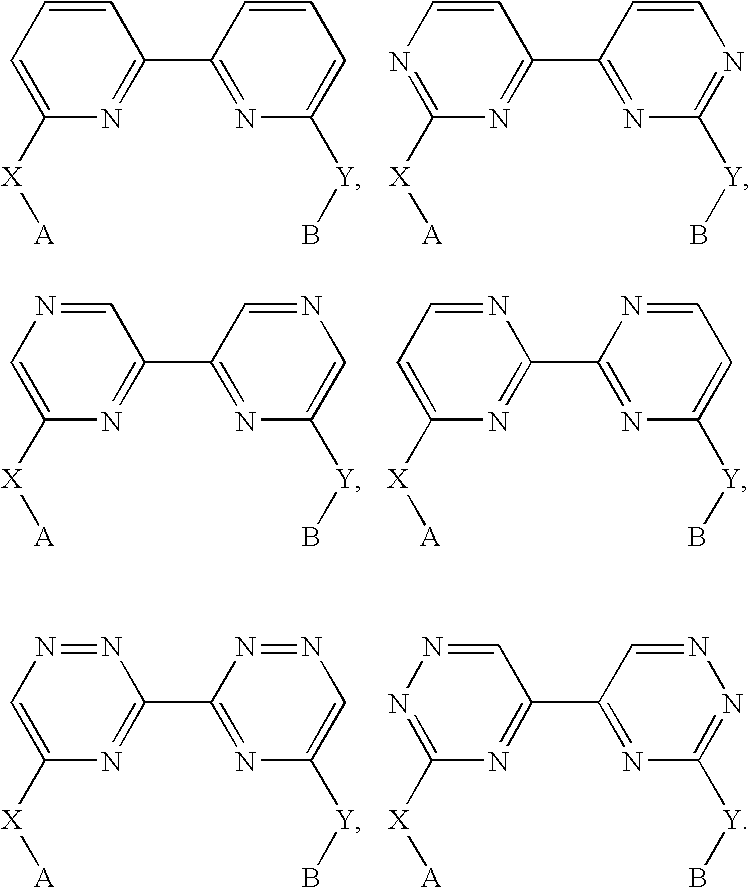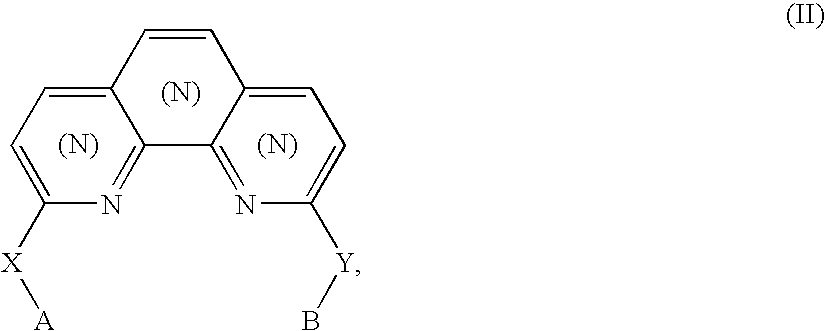Biheteroaryl metal complexes as bleach catalysts
a technology of biheteroaryl metal complexes and bleach catalysts, which is applied in the direction of metal/metal-oxide/metal-hydroxide catalysts, physical/chemical process catalysts, other chemical processes, etc., can solve the problem of unfavorable bleaching performance, shift in ph value, and insufficient bleaching performance of most bleaching activators at low temperature, etc. problem, to achieve the effect of gentle action on laundry
- Summary
- Abstract
- Description
- Claims
- Application Information
AI Technical Summary
Benefits of technology
Problems solved by technology
Method used
Image
Examples
example 1
Preparation of 1,10-bis(2-hydroxyphenyl)phenanthroline H2(bpphen): 2,9-bis(2-methoxyphenyl)-1,10-phenanthroline[1]
2C7H7BrO+2 Li→2 C7H7OLi
2C7H7OLi+C12H6N2→C26H20N2O2
[0137]60 g (0.32 mol) of bromoanisole are dissolved in 50 mL of ether and slowly added dropwise at 0° C. to a suspension of 8.9 g (1.28 mol) of lithium in 50 mL of ether. The reaction mixture is then raised to RT within one hour, after which it is refluxed for one hour. After cooling, excess lithium is separated with a reverse-sintered filter (Celite) and the solvent is removed from the filtrate under a vacuum. The remaining residue is redissolved in 100 mL of toluene and a solution of 4.56 g (23 mmol) of 1,10-phenanthroline * H2O in 150 mL of toluene is added dropwise at 0° C. to the resultant suspension of a virtually colorless solid in a yellowish solution. The resultant blood-red solution is raised to RT and refluxed for a further 5 h. After cooling, the mixture is quenched with 50 mL of water and extraction performe...
example 2
Washing Test in Model Washing Installation
[0146]The washing test is performed in a temperature-controllable multistirrer. 1 l glass beakers containing an apparatus for mechanically stirring the washing liquor are used as the test vessels. The stirring mechanism is designed such that, on the one hand, all the beakers are stirred at the same speed and, on the other hand, the direction of stirring changes periodically. The washing chambers are filled with approx. 16 g of ballast laundry and approx. 6 g of soiled fabric (the fabric portions are cut into squares of an edge length of approx. 6 cm and consist of cotton). All the test fabrics are manufactured by CFT B.V. (Netherlands).
[0147]The soiled fabric comprise the following test substrates of relevance to bleaching:
[0148]
CS-103red wineCS-3aged red wineBC-1teaBC-3teaCS-15blueberry juice
A set of eight soiled fabric portions is prepared from these 5 test fabrics for testing. This means that three of the types of soiling are represented ...
PUM
| Property | Measurement | Unit |
|---|---|---|
| pH | aaaaa | aaaaa |
| particle size | aaaaa | aaaaa |
| particle size | aaaaa | aaaaa |
Abstract
Description
Claims
Application Information
 Login to View More
Login to View More - R&D
- Intellectual Property
- Life Sciences
- Materials
- Tech Scout
- Unparalleled Data Quality
- Higher Quality Content
- 60% Fewer Hallucinations
Browse by: Latest US Patents, China's latest patents, Technical Efficacy Thesaurus, Application Domain, Technology Topic, Popular Technical Reports.
© 2025 PatSnap. All rights reserved.Legal|Privacy policy|Modern Slavery Act Transparency Statement|Sitemap|About US| Contact US: help@patsnap.com



